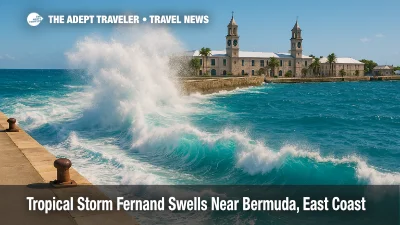Martinique
Nestled in the heart of the Caribbean's shimmering azure embrace, Martinique is a symphony of vibrant colors and intoxicating aromas that beckon travelers from around the world. As you travel to Martinique, picture yourself strolling through sprawling plantations of fragrant sugarcane, breathing in the sweet mingling of sun-warmed earth and sea breeze. The island's volcanic peaks are cloaked in lush emerald canopies, offering panoramic views that inspire awe and wanderlust in equal measure. In the bustling markets of Fort-de-France, you are greeted by the lively cadence of Creole rhythms that dance in the air, while the spicy scent of rich Creole cuisine weaves an irresistible spell, inviting you to savor the piquancy of local pepperpot stew and ripe tropical fruits. Whether basking on the sun-drenched sands of Les Salines or exploring the historical echoes in the ruins of Saint-Pierre, Martinique promises an enchanting mosaic of experiences that awaken the senses and enrich the soul, tantalizing every traveler's desire to delve deeper into its magical tapestry.
Martinique Travel Season
Travel to Martinique offers a blend of stunning beaches, vibrant culture, and lush landscapes. Understanding the best travel season can enhance your experience considerably. Martinique's peak travel season typically spans from December to April. During these months, visitors are met with the most favorable weather, boasting dry, sunny days and cooler evenings, making it ideal for beach outings and exploring the island's lush interior. However, this also means that larger crowds are present, and prices tend to rise, particularly around the Christmas and New Year holidays, as well as during Easter.
If you prefer visiting when the weather is still pleasant but want to avoid the throngs of tourists, consider traveling to Martinique in the shoulder seasons, which are from May to June and November. During these months, the island enjoys warm temperatures, fewer tourists, and more competitive rates on accommodations and flights. This time of year can be perfect for beach enthusiasts looking to enjoy calmer waters and for hikers eager to explore trails without the congestion of peak travelers.
The off-peak season in Martinique runs from July to October, coinciding with the Atlantic hurricane season. While the chances of encountering a hurricane are relatively low, there is an increased likelihood of rain showers. That said, traveling to Martinique during this time offers its own unique perks. Prices drop significantly, and travelers who venture out during this season will find the island more peaceful and can take advantage of budget-friendly deals. It’s also an excellent opportunity to experience Martinique's local culture and events, such as the Fête de la Mer in August, which showcases the island's maritime heritage with boat races and sea-themed festivities.
Throughout the year, Martinique celebrates various vibrant festivals that can provide a culturally enriching experience for visitors. In February or March, the island hosts its famous Carnival, a lively event filled with parades, music, and dance. Regardless of the season you choose to travel to Martinique, you can expect to engage with warm, friendly locals and savor the island’s unique Creole cuisine.
When planning your travel to Martinique, consider your personal preferences for weather, crowd size, and budget. Each season offers a unique perspective of this beautiful island. Whether you're visiting during the bustling peak months with their optimal weather, the quieter shoulder seasons with pleasant conditions and fewer tourists, or even the off-peak period with its peaceful ambiance and cultural events, Martinique promises an unforgettable experience.
The Weather and Seasons in Martinique
Travel to Martinique and explore its unique weather patterns, which showcase the serene beauty of this Caribbean island while offering diverse climatic experiences throughout the year. Located in the Lesser Antilles, Martinique enjoys a tropical climate characterized by two main seasons: the dry season and the wet season, each bringing distinct weather phenomena and exciting opportunities for visitors.
The Dry Season: A Promising Time for Travel
The dry season in Martinique typically spans from December to April, making it an ideal period for travel to Martinique. During these months, travelers can expect pleasant temperatures ranging from 77°F to 84°F (25°C to 29°C). This period is noted for its reduced humidity, often hovering around 70%, allowing for comfortable exploration of the island's beautiful beaches and lush landscapes. Rainfall is less frequent, with only occasional showers that are usually brief, further enhancing the appeal of outdoor activities.
The Wet Season: Refreshing Showers and Vibrant Nature
From May to November, Martinique transitions into its wet season. Those planning to travel during this period should anticipate a rise in humidity levels and an increase in rainfall. Daily temperatures during these months typically range from 77°F to 88°F (25°C to 31°C), offering warmer conditions. The island sees most of its rainfall from August to October, with September being particularly wet. Though the wet season brings more rain, these showers are often interspersed with sunny spells, creating a vibrant and lush environment as the island's flora thrives.
Optimal Travel Conditions and Considerations
For those looking to travel to Martinique, the most favorable weather conditions are often found during the dry season when the island experiences its mildest and driest conditions. This season aligns with the peak travel period, making it an excellent time to experience local festivals and events. The "Carnival," celebrated in February, is a highlight for many travelers, featuring vibrant parades and cultural festivities that showcase Martinique's rich heritage.
Even though the wet season might deter some due to its increased rainfall, it can be a rewarding time to visit for travelers looking to experience Martinique's natural beauty at its lushest. Additionally, this period tends to see fewer tourists, offering a more tranquil and intimate experience of the island. However, travelers should note the potential for hurricanes during these months, as the island is occasionally affected by tropical storms.
In summary, travel to Martinique offers a rich blend of experiences shaped by its dynamic climate. Whether traversing the pristine beaches or hiking through the rainforest, understanding the seasonal weather patterns can enhance any journey to this enchanting Caribbean destination. Travelers can look forward to warm temperatures, a welcoming atmosphere, and a bounty of cultural and natural attractions ready to be explored.
Accepted Payment Methods and Other Payment Information in Martinique
Travel to Martinique offers an opportunity to experience the vibrant culture and beautiful landscapes of this French Caribbean island. Understanding the payment options available can enhance your visit by preparing for transactions at local markets, restaurants, and other venues. The official currency in Martinique is the Euro (EUR), as the island is an overseas region of France. Euros are widely used across Martinique, making it simple for travelers from Europe to transition without needing a currency exchange.
Visitors to Martinique will find that credit card usage is convenient and accepted in many places. Visa and Mastercard are the most commonly accepted credit cards and can be used at most hotels, restaurants, and larger retailers. Many travelers find these cards to be reliable for accessing funds while they explore the island. However, smaller establishments, especially in more remote areas, might prefer cash or have minimum purchase requirements for card transactions. While American Express cards are accepted at some locations, their acceptance is not as widespread as that of Visa or Mastercard. Travelers should note that Discover cards have limited acceptance and it's advisable to carry an alternative form of payment, such as a Visa or Mastercard, to avoid inconvenience.
When planning travel to Martinique, it's a good idea to have a mix of payment options to ensure smooth transactions during your stay. Cash is still king in certain parts of the island, particularly in markets, smaller towns, and rural areas where card machines are less common. Having a supply of smaller denominations is particularly useful for local eateries, taxis, and tipping.
Tipping in Martinique is generally appreciated but not obligatory. In restaurants, a service charge is often included in the bill, much like in mainland France, which is typically around 15%. However, leaving some additional change for good service is seen as a kind gesture. Tipping taxi drivers, hotel staff, and tour guides is also customary, usually a few Euros is sufficient to show appreciation.
Travel to Martinique can be a richly rewarding experience with the right preparation. Be sure to notify your bank before traveling to ensure your credit cards are not blocked due to unusual activity, and consider setting up travel alerts. While Martinique is a French territory with a stable financial infrastructure, power outages and internet issues can occasionally disrupt card payments, making it handy to have cash on hand. As you enjoy your travel to Martinique, understanding these payment nuances will help you navigate your financial transactions smoothly while exploring everything this stunning island offers.
Why You Should Travel to Martinique
Martinique, an enchanting island in the Lesser Antilles, offers a mesmerizing blend of French elegance and vibrant Caribbean culture. As travelers seek destinations that combine natural beauty, rich history, and diverse experiences, Martinique emerges as a top choice.
Cultural Melting Pot
Travel to Martinique to experience a unique cultural tapestry that merges French and Creole influences seamlessly. Strolling through the streets of Fort-de-France, visitors are greeted by the harmonious coexistence of European architecture and traditional Creole cottages, which reflect the island's colonial past and dynamic heritage. The local music, dance, and culinary scene also embody this vibrant fusion, captivating all who visit.
Breathtaking Natural Beauty
Martinique is a paradise for nature lovers. The island's diverse landscape includes lush rainforests, towering mountains, and pristine beaches. Mount Pelée, an impressive active volcano, offers adventurous hikes with panoramic views. At the same time, Les Salines, one of Martinique's most famous beaches, boasts powdery white sand and crystal-clear waters, perfect for sunbathing and swimming.
Rich Historical Heritage
Immerse yourself in Martinique's intriguing history, which is deeply rooted in its colonial past. La Savane des Esclaves, an open-air museum, provides a poignant look into the island's history of slavery and its cultural evolution. The numerous sugar plantations and rum distilleries that dot the landscape tell the story of Martinique's agricultural and industrial past, offering guided tours that include tastings of the island's famous rum.
Gastronomic Delights
Travel to Martinique for a culinary adventure unlike any other. The island's cuisine is a delightful fusion of French and Creole flavors. From the fresh seafood available at the local markets to traditional dishes like Colombo and accras, Martinique is a food lover’s paradise. Top it off with the locally produced rum, a reflection of Martinique's rich agricultural history, and your taste buds will thank you.
Vibrant Local Festivals
Experience the lively festivals of Martinique, where the island's cultural vibrancy truly shines. Events such as the Carnival and the Tour des Yoles Rondes are a feast for the senses, with colorful parades, rhythmic music, and energetic dancing. These festivals are not only a celebration of Martinique's cultural richness but also an invitation for travelers to partake in the joyful spirit of the island.
Underwater Adventures
Diving enthusiasts will find a mystical underwater world when they travel to Martinique. The island's marine environment is a treasure trove of vibrant coral reefs and diverse marine life, including sea turtles, colorful fish, and even the occasional dolphin. Various diving spots, like the Bay of Saint-Pierre, offer breathtaking underwater vistas and historical shipwrecks waiting to be explored.
Stunning Botanical Gardens
For those with a penchant for flora, the Jardin de Balata is an unmissable attraction. This breathtaking botanical garden, filled with exotic plants and flowers, showcases the natural beauty of Martinique's lush environment. The garden's carefully designed pathways and informative displays make it a haven for photographers, artists, and nature enthusiasts alike.
Warm and Friendly Locals
The people of Martinique are known for their warm hospitality and friendly demeanor. Travelers often remark on the kindness and helpfulness of the locals, who are eager to share their love for the island with visitors. Whether it's through a casual conversation in a local market or a guided tour, the island's residents are integral to the welcoming atmosphere that makes Martinique so special.
Convenient Accessibility
Travel to Martinique is made seamless by its direct flights from major cities in North America and Europe, and its use of the Euro makes it a convenient destination for European travelers. The island's infrastructure is well-developed, with excellent transportation options, including taxis, buses, and car rentals, making it easy to explore all that Martinique has to offer.
Sustainable Tourism Practices
Amid a global push for responsible travel, Martinique stands out with its commitment to sustainable tourism. The island has taken significant steps to preserve its natural ecosystems and cultural heritage, from eco-friendly hotels to community-based tour initiatives. Travelers can enjoy the island's beauty while knowing their visit supports local conservation and empowerment efforts.
The History of Martinique
Martinique, a captivating island nestled in the Caribbean Sea, has a rich history that beckons travelers to explore its vibrant past. The chronicles of Martinique begin with its indigenous Arawak and Carib peoples, who inhabited the island until the arrival of European colonizers. Christopher Columbus sighted Martinique on his fourth voyage in 1502, but it wasn’t until 1635 that France established its first settlement. This marked the beginning of a tumultuous period characterized by battles for control, as the island changed hands several times between the French and British. The enduring French influence is evident today, as Martinique remains an overseas department of France, highlighting its unique blend of Caribbean and European cultures.
A visit to Martinique offers history lovers an opportunity to follow in the footsteps of these historical events through its numerous landmarks. Fort-de-France, the island’s capital, is home to Fort Saint-Louis, a 17th-century military fortress offering panoramic views of the bay and a window into the island's colonial military history. The Schoelcher Library, a remarkable architectural treasure, stands as a testament to Martinique’s cultural heritage, named after the abolitionist Victor Schoelcher, who played a pivotal role in ending slavery in the French colonies. The island's diverse history is also found in the famed ruins of Saint-Pierre, known as the "Paris of the Caribbean," which was dramatically destroyed by a volcanic eruption in 1902, offering a poignant reminder of nature's power.
For those seeking to travel to Martinique, the island's historical appeal is matched by its stunning natural beauty. The lush landscapes of Mount Pelée, not far from the tragic ruins of Saint-Pierre, provide a backdrop for understanding the island’s volcanic history. The Jardin de Balata, a lush botanical garden, showcases the island’s diverse flora, offering an escape into Martinique’s natural history. History lovers will also appreciate the island's enduring spirit and its ability to honor its past while embracing modernity. Traveling to Martinique is not just a journey through time, but a celebration of resilience and cultural richness that continues to enchant every visitor who steps onto its shores. This allure ensures that Martinique is a captivating travel destination for anyone interested in history, culture, and the undeniable beauty of the Caribbean.
The Culture of Martinique
Visitors who travel to Martinique will find themselves enthralled by the island's vibrant culture, which is a striking blend of African, French, and Caribbean influences. As an overseas region of France, Martinique boasts a unique identity where European elegance seamlessly meets the lively spirit of the tropics. This cultural amalgamation is vividly expressed through the island's traditions, festivals, and daily customs, offering a truly unforgettable experience for those who adventure to its shores. The people of Martinique are known for their warmth and welcoming nature. Their open arms invite travelers to partake in the rhythmic heartbeat of the island, where every street and corner tells a story of its rich and layered history.
One of the most extraordinary aspects of Martinique's culture is its festivals, which provide an immersive experience into the island's lively traditions. Carnival is, without a doubt, the crowning jewel of these celebrations, a vibrant explosion of color, music, and dance that is held every year before Lent. This grand event showcases a mesmerizing array of costumes, traditional music such as zouk and biguine, and captivating dances that reflect the island's African and French roots. Another significant festival is La Fête de la Musique, an annual music festival that brings together various genres and performers in a joyous homage to the universal language of music. Visitors traveling to Martinique during these festivals will find themselves swept up in the contagious energy and festive spirit, providing memories that will last a lifetime.
Daily customs in Martinique also reflect the island's cultural diversity, offering travelers insight into the nuances of local life. The Creole language, widely spoken alongside French, is a testament to the island's multicultural makeup and is often heard in casual conversation, music, and even street art. The culinary scene, an essential aspect of Martique's cultural expressions, combines flavors and techniques from African, French, and Indian cuisines. Dishes such as accras de morue (saltfish fritters) and Colombo curry are beloved by locals and visitors alike, each bite serving as a delicious illustration of Martinique's rich cultural blend. These culinary delights are enjoyed on a leisurely basis, as the island's rhythm encourages a slower pace, allowing time to savor both food and company.
Art and music play an integral role in Martinique's cultural expressions, with the island being a fertile ground for creative talents. The local artists draw inspiration from their surroundings, producing vibrant works that capture the island's natural beauty and historical narratives. Craftsmanship is also a celebrated tradition, with local artisans creating everything from hand-woven baskets to intricate jewelry. Visitors who travel to Martinique can explore art galleries and craft markets to find unique souvenirs that reflect the island's artistic spirit. Music is the lifeblood of Martinique, with genres like zouk, riddim, and mazurka weaving the threads of the island's cultural tapestry. These rich cultural expressions not only make Martinique a captivating destination but also provide a profound understanding of the island's unique identity and its people's enduring spirit.
The Culinary Experience of Martinique
Travel to Martinique, and you'll quickly discover that this enchanting Caribbean island is not just a feast for the eyes but also a paradise for the taste buds. Influenced by its French colonial past and rich Creole heritage, Martinique's culinary scene is a melting pot of flavors, aromas, and textures. Local cuisine on the island showcases a delightful mesh of French sophistication and Caribbean heartiness, creating a vibrant gastronomic tapestry. Traditional dishes incorporate fresh seafood, local fruits, and spices like nutmeg and cinnamon, offering a true taste of the island's rich cultural mosaic.
One cannot visit Martinique without indulging in some must-try dishes. Start with the famous "Boudin Créole," a spicy sausage made from pork, onions, and a combination of island spices. Or perhaps savor "Accras de Morue," salt cod fritters known for their crispy exterior and soft, flavorful interior. Another not-to-be-missed delicacy is "Colombo," a tantalizing curry-like stew that embodies the essence of Creole cooking with its mix of chicken or lamb, seasoned with garlic, ginger, and turmeric. Be sure to explore markets where local vendors offer an array of fresh produce and home-cooked specialities, granting travelers a genuine taste of everyday life in Martinique.
Complementing the island's culinary delights are its distinctive beverages. Martinique is renowned for its rum, particularly "Rhum Agricole," a uniquely crafted spirit made from freshly pressed sugarcane juice as opposed to molasses. This results in a smoother, more flavorful rum that is a staple in local cocktails like "Ti' Punch." Wine lovers will also be overjoyed, as French imports are bountiful, offering an array of both classic and innovative options. The local beer, "Lorraine," serves as a refreshing choice to enjoy alongside a sunset view. Seasonal variations amplify the intoxicating journey, with Ti' Punch variations available only at specific times of the year.
The vibrant culinary scene in Martinique is also reflected in its variety of dining experiences, catering to all preferences and dietary needs. From elegant fine dining establishments where fresh seafood is the star, to bustling food markets full of vegan and vegetarian options, travelers with specific dietary requirements will find plenty to enjoy. Unique dining experiences in Martinique include street food adventures, offering everything from fresh coconuts to smoked fish on the go. Additionally, Martinique hosts annual food festivals that attract foodies from all over the world, celebrating the island's diverse culinary heritage and offering workshops and tastings that showcase the rich history and innovative spirit that define the cuisine of Martinique.
What to See and Do in Martinique
Travel to Martinique offers a tapestry of experiences that cater to every type of traveler, from families to adventure seekers. Nestled in the heart of the Caribbean, Martinique combines French sophistication with local Creole culture, making it a unique destination that promises an unforgettable journey.
Explore Fort-de-France
As the vibrant capital of Martinique, Fort-de-France is a must-see for visitors. This bustling city is a hub of cultural activity, featuring historical landmarks like the Fort Saint Louis and the Cathédrale Saint-Louis. Families will enjoy visiting La Savane park for leisurely walks or picnics, while solo travelers can indulge in the rich cultural tapestry at the Schoelcher Library. Its lively markets and waterfront cafés provide ample opportunities to absorb the local atmosphere.
Discover the Beauty of Les Salines Beach
For those yearning for the quintessential Caribbean beach experience, a trip to Les Salines Beach is essential. Located at the southern tip of Martinique, this beach is renowned for its long stretches of soft white sand and crystal-clear water, making it a paradise for families and sun-seeking adventurers alike. Swimmers, snorkelers, or those who simply enjoy lounging under a palm tree will find Les Salines an idyllic spot to unwind.
Hike the Trails of Mont Pelée
Adventure seekers who travel to Martinique should not miss the opportunity to hike Mont Pelée, the island's iconic volcano. This challenging trek rewards hikers with breathtaking views of the island and the Caribbean Sea. As you ascend the slopes, you’ll traverse lush rainforests and discover unique flora and fauna, making this an unforgettable experience for both seasoned and amateur hikers.
Indulge in Local Flavors at Marché Couvert
To truly appreciate Martinique's vibrant culture, visit the bustling Marché Couvert in Fort-de-France. This local market is a sensory delight, offering a wide array of freshly caught seafood, exotic tropical fruits, and aromatic spices. Food enthusiasts can savor the island’s culinary treasures, including spicy accras and traditional boudin. A visit here is not just about food, but also a chance to interact with friendly locals and immerse yourself in the island’s vibrant atmosphere.
Step Back in Time at Habitation Clément
Located in Le François, Habitation Clément is a beautifully preserved sugar plantation that offers deep insights into Martinique's colonial past. History buffs and families with children can explore its rum distillery, lush gardens, and an array of historical artifacts. The estate also serves as an art center, showcasing contemporary Caribbean art, making it a culturally enriching stop for anyone traveling to Martinique.
Unwind at Jardin de Balata
Just a short drive from Fort-de-France, the Jardin de Balata is a serene botanical garden that will captivate nature lovers with its lush beauty. The garden displays a vast collection of tropical plants, including colorful heliconias and towering palm trees. Families and solo travelers alike can wander along tranquil pathways while taking in panoramic views of the surrounding mountains and valleys.
Experience Martinican Nightlife in Les Trois-Îlets
Travelers looking for a vibrant nightlife experience should head to Les Trois-Îlets. This lively area is home to chic bars and clubs where live music and dancing are a nightly affair. Whether you’re into jazz, zouk, or salsa, the electrifying atmosphere will ensure an unforgettable night out in Martinique.
Sail the Caribbean Waters
A sailing excursion offers a unique way to explore Martinique's coastline and nearby islands. Families can enjoy a day trip sailing around Diamond Rock or snorkeling in the clear waters while solo travelers may relish the tranquility of the open sea on a private charter. Whether you choose a guided tour or rent a sailboat, the stunning natural beauty of the Caribbean Sea promises a memorable experience.
Explore the Ruins of Saint-Pierre
The town of Saint-Pierre, once known as the "Paris of the Caribbean," offers a poignant reminder of the past, with its volcanic ruins preserved since the devastating eruption of 1902. History enthusiasts will find exploring the remains of the theatre and the old town jail particularly compelling. This site provides a somber yet fascinating glimpse into Martinique's history and the resilience of its people.
Attend a Traditional Martinican Festival
Cultural immersion is paramount when you travel to Martinique, and attending a local festival offers just that. From the exuberant Carnival celebrations in February to the Célébration de la Musique in June, these events are a feast of dance, music, and color. Join the locals in traditional dress for a true cultural experience, leaving you with memories that capture the spirit and vibrancy of Martinican culture.
Tips & Tricks for Traveling in Martinique
When planning your travel to Martinique, understanding the local customs can significantly enhance your experience. Martinique is a delightful mix of French and Caribbean cultures, and while French is the official language, most locals appreciate basic French greetings and phrases. Make an effort to learn simple greetings like "Bonjour" (Good morning) or "Merci" (Thank you) to show respect for their culture and enrich your interactions with locals.
Optimize Your Transportation
Navigating Martinique efficiently can greatly improve your travel experience. Renting a car is the most practical way to explore the island at your own pace, especially for accessing the less touristy spots. Make sure to rent in advance and consider a smaller vehicle to navigate the narrow and winding roads comfortably. Alternatively, the public transportation system, known as "TCM," can be a cost-effective way to see the island, though it can be less reliable and restrict you to towns along bus routes.
Plan for Your Budget Effectively
Travel to Martinique can be as budget-friendly or luxurious as you choose. For a budget-friendly trip, consider visiting grocery stores for fresh produce and essentials, which can be cheaper than dining out. Lodging options also vary, with French-style gîtes offering charming and affordable alternatives to hotels. Keep in mind that credit cards are widely accepted, but it's wise to have some cash for markets and small eateries.
Discover the Local Food Scene
Martinique’s cuisine is a delightful fusion of French and Creole flavors, offering a unique culinary experience. Eat where the locals eat to enjoy authentic dishes such as "accras de morue" (cod fritters) and "colombo" (Caribbean curry). Don’t miss out on the bustling markets, like the Fort-de-France market, which offer an array of fresh produce, local spices, and exotic fruits that showcase the island’s rich food culture.
Timing is Everything
Choosing the right time to travel to Martinique can impact your experience. The dry season from December to April is the most popular, offering pleasant weather and attracting more visitors. For lower prices and fewer crowds, you might prefer to visit during the wet season from June to November, but be mindful of the potential for hurricanes. Always check the local weather forecasts before your trip to be well-prepared.
Explore Beyond the Beaches
While Martinique is renowned for its stunning beaches, the island offers much more to explore. Venture into the lush rainforests, hike Mount Pelée for incredible views, or visit the charming towns of Saint-Pierre and Les Trois-Îlets, rich in history and culture. Engaging in these activities allows a deeper understanding and appreciation of the island’s diverse landscapes and heritage.
Respect Local Customs and Etiquette
Embrace the courteous and relaxed nature of Martinique’s culture by respecting local customs. It's customary to greet people formally with "Bonjour" when entering shops or initiating conversations. Respect the peaceful atmosphere by keeping noise levels low in public spaces and beaches. Understanding and behaving in accordance with local customs will make your interactions more pleasant and mutually respectful.
Avoid Crowds with Off-the-Beaten-Path Adventures
To escape the crowds, try less frequented but equally captivating spots. The small town of Sainte-Anne offers tranquil beaches, like Les Salines beach, and picturesque landscapes. Visiting during weekdays and early mornings also ensures a more serene experience. Engaging in activities like snorkeling in lesser-known bays or hiking lesser-traveled trails offers a unique and intimate look at Martinique's beauty.
Safety Tips for Solo Travelers
For solo travelers, Martinique is generally safe but taking some precautions will enhance your peace of mind. Stick to well-populated areas, especially in the evenings. Inform someone about your itinerary when exploring remote locations, and keep your belongings secure. Solo travelers often find that the friendliness of the locals adds to the island’s welcoming atmosphere, boosting their independence and adventure safety.
Photography Tips for Capturing the Island's Beauty
Martinique offers stunning vistas perfect for photography enthusiasts. Capture the island’s vibrant sunsets by positioning yourself westward, such as Anse Dufour. For nature shots, the Jardin de Balata offers an array of exotic plants and flowers. To photograph local life, visit fishing villages like Anses d'Arlet, where colorful boats and bustling markets provide dynamic and lively scenes.
What To Know Before You Go to Martinique
Travel to Martinique offers a unique blend of French and Caribbean cultures. Visitors planning to travel to Martinique should be well-prepared to ensure a smooth and enjoyable trip. Understanding the entry requirements and local customs is crucial for a hassle-free travel experience.
Entry Requirements
When you travel to Martinique, being informed about entry requirements is essential. As an overseas department of France, Martinique adheres to the same entry rules as mainland France. Generally, European Union citizens don’t require a visa for stays up to 90 days. Travelers from other regions should check the French consulate's website for their specific visa requirements. It’s advisable to have a return ticket as well as proof of accommodation. While no specific vaccinations are required to travel to Martinique, it’s prudent to ensure routine vaccinations are up to date. Consider vaccinations for hepatitis A and B, especially if you plan to travel extensively within the island.
Local Customs and Etiquette
When traveling to Martinique, understanding local customs can enhance your experience. Martinique is a French territory, so French cultural norms apply. Greeting others with a polite "Bonjour" is expected, and it’s customary to shake hands or kiss on both cheeks in a friendly manner. Dress codes tend to be casual but maintaining a neat and tidy appearance is appreciated, especially in dining establishments.
Transportation Options
Navigating around Martinique is straightforward with several transportation options available. Rental cars provide the flexibility to explore the island at your own pace, although be aware that driving is on the right-hand side. Public buses offer an affordable alternative, although they might not cover all areas. Taxis are available, but it’s best to confirm fares before starting your journey. An emerging option is app-based ridesharing, which is increasing in popularity.
Tipping Culture
Tipping in Martinique follows the French custom where service charges are typically included in bills at restaurants. However, leaving a small tip for exceptional service is appreciated. It’s customary to round up to the nearest Euro for smaller expenses like taxi rides or at cafes.
Common Phrases
French is the official language in Martinique, so travelers should familiarize themselves with a few basic phrases. Common phrases such as "s’il vous plaît" (please), "merci" (thank you), and "au revoir" (goodbye) can be very helpful. While English is spoken in tourist areas, an effort to speak French is always well-received.
Health Precautions and Travel Insurance
Health considerations are important while traveling to Martinique. Protect against mosquitoes by using repellents, as there is a presence of mosquito-borne diseases. Drinking bottled water is advised, although tap water is generally safe. Travel insurance is highly recommended to cover unexpected medical and travel emergencies.
Communication Tips
For non-native French speakers, downloading a translation app can be useful when navigating interactions or reading signs. Locals appreciate when travelers make an effort to speak their language, and a simple phrasebook can serve as a handy tool. Wi-Fi is commonly available in hotels and cafes, allowing easy access to communicate with loved ones back home or to access language resources.
Accessibility in Martinique
Travel to Martinique offers an enriching experience with its vibrant culture, stunning landscapes, and a strong emphasis on inclusivity and accessibility. For travelers with diverse needs, there are essential factors to consider to ensure a comfortable visit. Whether you have limited mobility, use a wheelchair, or require visual or auditory accommodations, Martinique is steadily developing its facilities and infrastructure to meet various accessibility needs.
Physical Accessibility for Travelers with Limited Mobility
Many areas in Martinique are accessible to travelers with limited mobility, with numerous hotels and accommodations catering to these needs. Some upscale and mid-range hotels feature rooms equipped with roll-in showers and wider door frames to accommodate wheelchair users. Public spaces like the Fort-de-France city center have undergone improvements to enhance wheelchair accessibility. Sidewalks in key tourist areas often include curb cuts and tactile paving to assist those using wheelchairs or with other mobility devices. While not all areas are fully accessible, continuous efforts are being made to improve the infrastructure.
Accessible Public Transportation in Martinique
Public transportation in Martinique includes buses and taxis, with some services better equipped than others for accessibility. Certain bus routes feature low-floor buses, making boarding and disembarking easier for wheelchair users. However, it’s advisable to check with local providers about specific routes and schedules to ensure accessibility needs can be met. Taxis equipped with necessary features for disabled travelers are available, but booking in advance is highly recommended. Renting accessible vehicles is another excellent option for a more flexible exploration of the island.
Visual and Auditory Accommodations
Efforts to provide visual and auditory accommodations for travelers are present, but they might not be as widespread as mobility-focused infrastructure. Establishments such as hotels and restaurants are increasingly aware of the importance of these accommodations. Larger resorts might offer services like Braille menus and assistance for those with visual impairments. Moreover, audio guides in some key tourist attractions are available, although it’s advisable to reach out beforehand to confirm availability and specifics.
Accessible Tourist Attractions in Martinique
Martinique boasts several tourist attractions that cater to travelers with accessibility needs. The Jardin de Balata, a beautifully curated botanical garden, offers some accessible pathways for wheelchair users and individuals with mobility challenges. Furthermore, the Martinique Zoo, located in the north of the island, provides accessible facilities like ramps and rest areas. Some beaches also have enhanced accessibility features, such as ramps leading directly to the shore, allowing all visitors to enjoy Martinique's stunning coastlines.
Travel to Martinique, while a fulfilling experience, poses certain challenges for those requiring specific accessibility accommodations. Continuous improvements and raised awareness among service providers are gradually increasing the ease of travel across the island for everyone. As the landscape of tourism broadens, Martinique remains dedicated to promoting inclusivity, ensuring that all travelers can savor the island's rich cultural and natural offerings.
Health & Safety in Martinique
Travel to Martinique offers a unique blend of cultural richness and natural beauty, drawing numerous visitors each year. While the island is generally considered safe for travelers, it is essential to be informed about potential safety concerns. Being aware of these issues allows you to fully enjoy your time on this stunning island with peace of mind.
Water Safety
Martinique's beaches are renowned for their beauty, but it is crucial to observe water safety measures. Some beaches may not have lifeguards, and dangerous currents or sudden waves can occur without warning. Swimming only in designated areas and respecting posted safety signs are recommended. Additionally, travelers should exercise caution when engaging in water sports and consider wearing life jackets for added security.
Natural Disaster Risks
Due to its location in the Caribbean, Martinique is susceptible to natural disasters such as hurricanes and tropical storms, particularly during the hurricane season, which runs from June to November. Travelers should monitor weather forecasts and heed any warnings or advisories issued by local authorities. Familiarizing oneself with emergency procedures and shelters is also prudent when planning travel to Martinique during these months.
Crime Concerns
While Martinique is generally a safe travel destination, petty crime such as pickpocketing and theft can occur, especially in crowded areas and popular tourist spots. Travelers are advised to keep their belongings secure and be mindful of their surroundings. It is wise to avoid displaying signs of wealth and to use hotel safes to store valuables. Taking these precautions will help minimize the risk of becoming a victim of theft.
Health and Safety Precautions
Visitors to Martinique should be aware of health and safety measures to ensure a smooth travel experience. There are no specific vaccination requirements for travel to Martinique, but it is advisable to be up to date on routine vaccines. Access to healthcare is relatively good, with several hospitals and medical facilities available in populated areas. Nonetheless, obtaining comprehensive travel insurance that covers medical expenses is highly recommended. Additionally, travelers should protect themselves against mosquitoes, which can carry diseases such as dengue fever.
Political and Social Climate
Martinique, as a part of France, enjoys a stable political environment with no recent history of social unrest affecting tourists. Visitors can generally feel secure while exploring the vibrant culture and scenic landscapes the island offers. Keeping informed about local news and events can be beneficial, although the likelihood of encountering political issues during normal tourist activities remains low.
Ultimately, while travel to Martinique generally presents minimal risks compared to many destinations, maintaining awareness of these safety considerations will enhance your experience. Being prepared ensures that you can immerse yourself in the vibrant charm of Martinique with confidence and ease.
Other Places You Might Like
Guadeloupe - Often considered a sister island to Martinique, Guadeloupe shares a similar blend of French and Creole cultures, providing travelers with a rich tapestry of experiences. Adventurers who enjoy the lush rainforests, stunning beaches, and vibrant local culture while traveling to Martinique will find Guadeloupe equally fascinating. With its two main islands connected by a mangrove swamp, visitors can explore Basse-Terre’s volcanic landscapes and Grande-Terre’s sandy shores, offering a harmonious balance of nature and relaxation reminiscent of Martinique’s allure.
Saint Lucia - Just a short boat ride away from Martinique, Saint Lucia offers a breathtaking mix of volcanic beaches, luxury resorts, and charming fishing villages, wrapped in lush greenery. Travelers who were enchanted by Martinique's stunning Pitons and lush landscapes will find Saint Lucia's twin volcanic spires, Gros Piton and Petit Piton, equally captivating. The island's dedication to preserving its natural beauty makes it ideal for eco-tourists and those who enjoyed the natural, unspoiled beauty that Martinique presents.
Seychelles - For travelers who fell in love with Martinique’s idyllic beaches and azure waters, the Seychelles offer an exotic escape with some of the world's most beautiful islands. Each island offers unique experiences, from giant tortoises roaming freely in the Aldabra Atoll to the vibrant underwater world teeming with marine life at the Coral Garden of St. Anne National Marine Park. The Seychelles' emphasis on sustainable tourism resonates with Martinique's eco-conscious visitors who revel in pristine beaches and diverse ecosystems.
Bali, Indonesia - Known for its vibrant culture and dramatic landscapes, Bali can enchant those who appreciate Martinique's lively festivals and scenic beauty. Travelers will relish in Bali’s rice terraces, ancient temples, and the warm hospitality of its people. With a similar tropical climate, Bali offers adventures for every type of traveler — from surfing on pristine beaches to exploring the rich cultural history — making it a perfect destination for those longing for the sights and sounds reminiscent of their travel to Martinique.
Barbados - This Caribbean gem presents a lively atmosphere combined with picturesque beaches and lush botanical gardens, captivating those who enjoyed the lively culture and breathtaking scenery of Martinique. In Barbados, opportunities to explore historic plantation homes, like St. Nicholas Abbey, mirror the history-laden visits in Martinique. Furthermore, the island's culinary scene, blending African, Indian, and British influences, can delight food lovers keen on Caribbean tastes similar to those they found on their travels to Martinique.
Punta Cana, Dominican Republic - With miles of white sandy beaches and crystal-clear waters, Punta Cana appeals to beach lovers who adored the coastal tranquility of Martinique. Offering a resort lifestyle paired with opportunities for excursions into the Dominican Republic’s captivating interiors, this destination provides a mix of relaxation and adventure. For people who enjoyed the water activities and beachside relaxation during their travel to Martinique, Punta Cana presents an enticing choice with its impressive coral reefs and diving spots.
Final Thoughts
Martinique is an enchanting blend of vibrant culture, lush landscapes, and tantalizing cuisine, making it a captivating destination for travelers seeking an exceptional Caribbean experience. When you travel to Martinique, you’ll invite yourself into a world where French sophistication meets island charm, providing a unique journey unlike any other. From exploring the historic towns and savoring Creole flavors to relaxing on pristine white-sand beaches and hiking its majestic mountains, Martinique promises an adventure for every type of traveler.
Travel to Martinique and immerse yourself in its rich cultural tapestry, where rhythmic music, colorful festivals, and welcoming locals create an atmosphere of joy and warmth. The island's diverse natural beauty is perfect for those looking to connect with nature, offering numerous opportunities for hiking, snorkeling, and beachcombing. Whether you're drifting along the crystal-clear waters or wandering through its vibrant local markets, every moment spent on this stunning island brings new discoveries and unforgettable memories.
If you’re looking for a destination that offers both relaxation and excitement, Martinique is the perfect choice. With its outstanding natural beauty, delectable culinary experiences, and a seamless blend of French and Caribbean influence, travel to Martinique can reinvigorate your senses and provide a refreshing escape. Let the exotic allure of Martinique draw you in for your next getaway, and find yourself enchanted by its many treasures. Book your travel to Martinique today, and set the stage for an extraordinary journey you’ll cherish forever.
Sainte Anne, Martinique

Venezuela Airspace Advisory, Caribbean Flights, February 2

Winter Blues Sale Caribbean Resorts: Sandals, Beaches

San Juan Cruise Delays After Venezuela Airspace Curbs

Windstar Caribbean Cruise Embarkation Delays After Closures

Venezuela Airspace Curbs Disrupt Caribbean Flights

Venezuela Airspace Warning Disrupts Caribbean Routes

Venezuela Airspace Warning Forces Flight Reroutes

Venezuela Airspace Warning Reroutes Caribbean Flights

2028 World Cruise From Miami To Athens With Azamara

Melissa Cuts Jamaica Rooms, Shifts Dominican Winter Trips

Caribbean disturbance could become Tropical Storm Melissa

Caribbean tropical disturbance may alter late-week cruises

Royalton debuts Royalton Suites & Villas for Diamond Club

Hurricane Gabrielle brings dangerous surf; Narda turns away

Carnival Firenze 2027 cruises: South America to Miami

Tropical Storm Fernand swells near Bermuda, East Coast

Caribbean travel demand surges, Aruba, D.R., Jamaica lead

Cat-5 Hurricane Erin drives SXM, USVI cancellations

Tropical Storm Erin Forecast: Insurance Clock, Swell Risks

Blue Diamond Becomes Royalton Hotels & Resorts

Tropical Storm Dexter to Stir Bermuda and Mid Atlantic Surf

Secrets Playa Esmeralda Opens September 1 in DR's Miches

Orient Express Corinthian Reveals 2026 Caribbean Season

Southwest to Launch St. Thomas Flights in February 2026

Sandals 'Feel the Warmth' Sale: $1,500 Credit, Free Cruise

